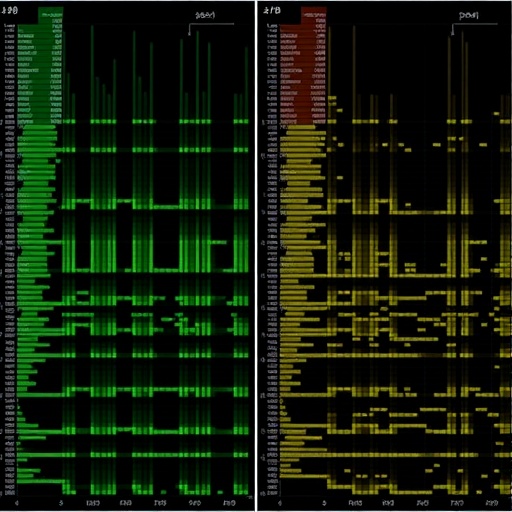In recent groundbreaking research, scientists have ventured into the intricate world of epigenetics and its correlation with sexual maturity, particularly focusing on the liver transcriptomes of male and female subjects. This significant study sheds light on how maternal obesity may influence the hepatic gene expression patterns during critical developmental milestones. Central to this research is the examination of H3K9me3 profiles, a crucial epigenetic marker, whose role in sexual differentiation is increasingly gaining recognition.
The liver, often referred to as the body’s metabolic hub, plays a pivotal role in a multitude of biological processes, including metabolism, detoxification, and hormone regulation. In understanding how sexual maturation affects liver functionality, researchers have meticulously mapped out sex-specific transcriptomes. This mapping not only emphasizes the distinctions between male and female hepatic profiles but also uncovers how these differences may impact health outcomes later in life, particularly in relation to obesity.
Maternal obesity has emerged as a significant public health concern, with subsequent generations potentially bearing the brunt of its effects. The study presented by Yadav and colleagues delves into this phenomenon by exploring the epigenetic changes caused by maternal obesity during pregnancy. The researchers argue that these epigenetic alterations are not just mere byproducts but rather factors that can potentially predispose offspring to metabolic disorders. The liver plays an integral role in these metabolic pathways, making it an essential focus for understanding the broader implications of maternal health.
At the core of this investigation are sex-specific differences that emerge in liver transcriptomes as subjects enter sexual maturity. Utilizing advanced genomic technologies, the researchers meticulously characterized the transcriptional landscapes of the livers from male and female models. This detailed examination revealed that distinct gene expression profiles are established, likely influenced by the hormonal milieu associated with sexual maturation. Such findings are pivotal in recognizing how sexual dimorphism manifests at the molecular level in crucial metabolic organs.
Moreover, the researchers utilized H3K9me3, an epigenetic marker associated with transcriptional repression, to further delineate the changes in gene expression brought about by maternal obesity. This histone modification is known for its role in silencing genes, and its dysregulation could have profound implications on liver function and overall metabolic health. By analyzing H3K9me3 profiles, the study demonstrates how maternal obesity could potentially influence the developmental trajectory of hepatic gene expression in a sex-specific manner.
The implications of these findings reach far beyond the confines of laboratory research. As public awareness of obesity’s health implications grows, so does the urgency for scientific inquiry into its transgenerational effects. The relationship between a mother’s health and her offspring’s metabolic profiles is not only a biological concern but also a societal one. Educating expectant mothers about the ramifications of obesity could transform public health strategies aimed at reducing the prevalence of metabolic disorders in future generations.
In addition to the immediate relevance of these findings, the study raises compelling questions about the potential reversibility of epigenetic changes initiated by maternal obesity. Research into targeted interventions that could mitigate these adverse effects is needed to promote healthier outcomes for offspring. The role of lifestyle modifications, dietary interventions, and exercise in reversing or reducing the epigenetic marks caused by obesity warrants further exploration.
Moreover, the research provokes discussions about the complexity of gene-environment interactions. How might environmental factors, beyond maternal obesity, influence liver development and function, and subsequently, metabolic health? The interplay between these variables is crucial to comprehensively understanding sexual dimorphism and its implications for disease susceptibility.
As scientists continue to uncover the molecular underpinnings of metabolic health, emphasis on the timing of environmental exposures will be paramount. The window of opportunity for intervention may be narrow but critical, suggesting that early-life conditions set the stage for lifelong health trajectories. This research underscores the necessity for a multidisciplinary approach, integrating genetics, epigenetics, nutrition, and health education in tackling obesity-related health issues.
The innovation of utilizing sex-specific transcriptomic profiles represents a significant advancement in personalized medicine. By appreciating the unique biological mechanisms at play in different sexes, future research and clinical interventions can be tailored to optimize health outcomes. This individualized approach has the potential to revolutionize how metabolic disorders are treated, enabling healthcare providers to offer more precise and effective interventions.
In conclusion, the research carried out by Yadav and colleagues is a monumental step toward understanding the intricacies of liver physiology, sexual maturation, and the overarching impacts of maternal obesity. Their findings not only contribute to the scientific literature but also serve as a clarion call for public health initiatives aimed at educating mothers about the implications of their health on their children. As the field of epigenetics continues to evolve, it is crucial to harness these insights to improve health outcomes across generations.
The exploration of sex-specific differences in hepatic gene expression, particularly following maternal obesity, opens avenues for new research focused on preventive measures and therapeutic strategies. Understanding how epigenetic modifications can be mitigated or reversed will be critical in addressing the obesity epidemic and its wide-reaching effects on metabolic health.
Ultimately, this research is a reminder of the interconnected nature of health, environment, and genetic predisposition. The journey to deciphering the complexities of our biology is ongoing and presents exciting opportunities for future discoveries. As researchers delve deeper into the epigenetic landscape of health and disease, the potential to illuminate the pathways that lead to optimal health remains a tantalizing frontier.
Subject of Research: The impact of maternal obesity on sex-specific liver transcriptomes and H3K9me3 profiles during sexual maturity.
Article Title: Establishment of sex-specific liver transcriptomes and H3K9me3 profiles during sexual maturity: the impact of maternal obesity.
Article References:
Yadav, A.K., Harris-Kawano, A., Saxena, R. et al. Establishment of sex-specific liver transcriptomes and H3K9me3 profiles during sexual maturity: the impact of maternal obesity.
Biol Sex Differ 16, 81 (2025). https://doi.org/10.1186/s13293-025-00767-8
Image Credits: AI Generated
DOI: 10.1186/s13293-025-00767-8
Keywords: maternal obesity, liver transcriptomes, H3K9me3, sexual maturity, epigenetics, metabolic health, sex differences.




